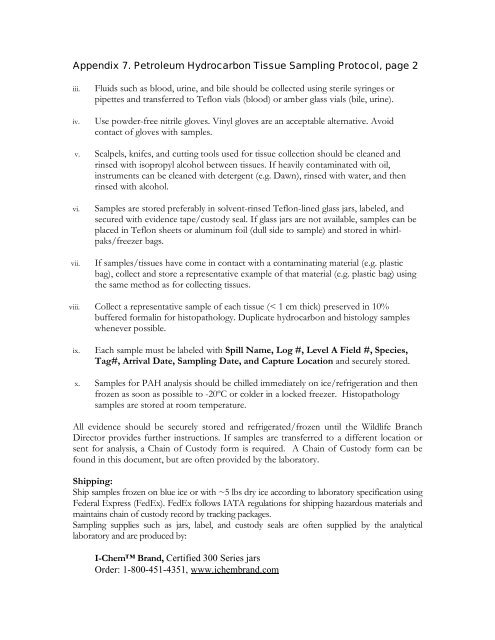Volume III, Appendices EM - National Marine Fisheries Service ...
Volume III, Appendices EM - National Marine Fisheries Service ...
Volume III, Appendices EM - National Marine Fisheries Service ...
You also want an ePaper? Increase the reach of your titles
YUMPU automatically turns print PDFs into web optimized ePapers that Google loves.
Appendix 7. Petroleum Hydrocarbon Tissue Sampling Protocol, page 2<br />
iii. Fluids such as blood, urine, and bile should be collected using sterile syringes or<br />
pipettes and transferred to Teflon vials (blood) or amber glass vials (bile, urine).<br />
iv. Use powder-free nitrile gloves. Vinyl gloves are an acceptable alternative. Avoid<br />
contact of gloves with samples.<br />
v. Scalpels, knifes, and cutting tools used for tissue collection should be cleaned and<br />
rinsed with isopropyl alcohol between tissues. If heavily contaminated with oil,<br />
instruments can be cleaned with detergent (e.g. Dawn), rinsed with water, and then<br />
rinsed with alcohol.<br />
vi. Samples are stored preferably in solvent-rinsed Teflon-lined glass jars, labeled, and<br />
secured with evidence tape/custody seal. If glass jars are not available, samples can be<br />
placed in Teflon sheets or aluminum foil (dull side to sample) and stored in whirlpaks/freezer<br />
bags.<br />
vii. If samples/tissues have come in contact with a contaminating material (e.g. plastic<br />
bag), collect and store a representative example of that material (e.g. plastic bag) using<br />
the same method as for collecting tissues.<br />
viii. Collect a representative sample of each tissue (< 1 cm thick) preserved in 10%<br />
buffered formalin for histopathology. Duplicate hydrocarbon and histology samples<br />
whenever possible.<br />
ix. Each sample must be labeled with Spill Name, Log #, Level A Field #, Species,<br />
Tag#, Arrival Date, Sampling Date, and Capture Location and securely stored.<br />
x. Samples for PAH analysis should be chilled immediately on ice/refrigeration and then<br />
frozen as soon as possible to -20ºC or colder in a locked freezer. Histopathology<br />
samples are stored at room temperature.<br />
All evidence should be securely stored and refrigerated/frozen until the Wildlife Branch<br />
Director provides further instructions. If samples are transferred to a different location or<br />
sent for analysis, a Chain of Custody form is required. A Chain of Custody form can be<br />
found in this document, but are often provided by the laboratory.<br />
Shipping:<br />
Ship samples frozen on blue ice or with ~5 lbs dry ice according to laboratory specification using<br />
Federal Express (FedEx). FedEx follows IATA regulations for shipping hazardous materials and<br />
maintains chain of custody record by tracking packages.<br />
Sampling supplies such as jars, label, and custody seals are often supplied by the analytical<br />
laboratory and are produced by:<br />
I-Chem Brand, Certified 300 Series jars<br />
Order: 1-800-451-4351, www.ichembrand.com
















